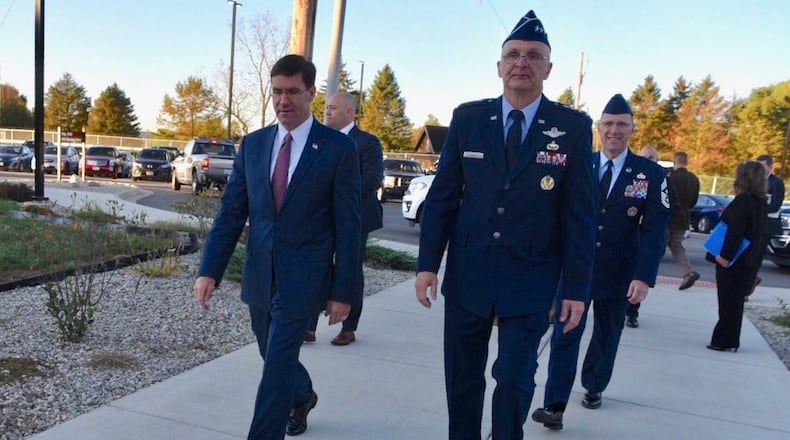Air Force planners are “retiring” 17 of the oldest B-1 bombers, 44 A-10 planes, 24 Global Hawk unmanned aerial vehicles or drones, as well as 16 KC-10 and 13 KC-135 tankers from the Air Force, according to a Military Times report that quotes an unnamed military official.
But replacing those aircraft with next-generation planes and technologies should be good for Wright-Patterson Air Force Base, where 30,000 military and civilian employees oversee logistics and research for all of the Air Force, said one defense analyst, Loren Thompson.
“This budget is good for Wright-Patterson because developing next-generation technologies is the centerpiece of the whole budget,” said Thompson, chief operating officer of the Lexington Institute, an Arlington, Va.-based analyst who is familiar with Wright-Patterson. “All the systems that are going away would not be able to survive in a future war against China.”
The overall reorienting of national defense strategies against larger adversaries — such as China and Russia — bodes well for Wright-Patterson and the work that happens or is overseen there, he said.
“When we were fighting terrorists, technology development was not the top priority,” Thompson said.
However, he added that hundreds of line items in the Air Force budget are secret, which makes analyzing it in detail difficult.
“It’s hard for an outsider to judge it,” Thompson said. “But the reason they’re secret is these are cutting-edge technologies that the Air Force doesn’t want America’s enemies to know about.”
“This budget is a strong step forward in keeping our country safe,” U.S. Rep. Mike Turner, R-Dayton, said in a statement. “I am particularly pleased that the White House is prioritizing nuclear deterrence and requesting the necessary funding to modernize our nuclear arsenal.
Added Turner: “Additionally, this proposed budget includes $23.5 million for the construction of a hydrant fuel system at Wright-Patterson Air Force Base. Now it is Congress’s responsibility to pass appropriations on time for our troops. I will continue to push for a robust national defense budget and will, as always, relentlessly advocate for the men and women at Wright-Patt who work daily to protect our nation from our adversaries.”
The budget request for the Air Force is $207 billion, up $1.7 billion from fiscal year 2020, aiming for a total force size of about 512,000, an increase of about 1,500 people.
The budget would increase overall military spending by less than half a percent, to $740.5 billion annually, while cutting non-defense spending by 5 percent, to $590 billion, according to early previews of the proposed spending plan.
Service members would see a 3 percent pay raise in 2021 under the proposed budget. Earlier this year, members of the military saw a pay increase of 3.1 percent.
Trump released the $4.8 trillion budget plan Monday, a blueprint for federal spending in the 2021 fiscal year, which begins Oct. 1.
However, with a divided Congress — Democrats control the House of Representatives while the Republicans control the Senate — the spending plan is unlikely to become law.
While the budget proposes slightly more money for the Pentagon, defense leaders were talking of a wide-ranging transformation late last week, saying they would move $5.7 billion toward “higher priority” technologically oriented projects, such as nuclear modernization, space missile defense, hypersonic weapons, artificial intelligence, 5G communications tech and readiness, according to industry web site Defense One.
Much of that modernization and research work could be overseen by commands and laboratories based at Wright-Patterson. The Air Force Materiel Command, Air Force Research Laboratory and the Air Force Life Cycle Management Center are all based at the sprawling Greene County base, where 30,000 military and civilian workers are employed.
“There’s a lot of talk all the time about reform, and we need to reform and do things differently,” Defense Secretary Mark Esper said Friday, speaking to students at Johns Hopkins School for Advanced International Studies, referring to some of the changes in military spending and focus. “It’s going to be time to help me make tough choices.”
As identified in a Fiscal Year 2021 Defense-Wide Review, much of the $5.7 billion that would be redirected would come from a de-emphasis, or less spending, on some personnel and benefits programs, warfighting and support, defense oversight, as well as working capital funds.
The warfighting and support areas that would be truncated include: The Defense Threat Reduction Agency, the Chem-Bio Defense Program, the Defense Security Cooperation Agency, Counter-Narcotics, Combatant Commander Exercise Engagement and Training Transformation and intel agencies, according to the review, which was released last month.
In particular, the defense-wide review says the Pentagon should “right-size” 50 military medical treatment facilities by implementing the National Defense Authorization Act for 2017, section 703.
That’s a reference to a section of the National Defense Authorization Act that concerns military hospitals and medical treatment facilities, directing a “comprehensive transformation” of the military health system.
Sen. Sherrod Brown, D-Ohio, and other Democrats were critical of Trump’s proposed cuts to domestic spending.
“President Trump’s budget proposal is yet another betrayal of working families in Ohio,” Brown said in a statement. “From his proposed cuts to earned benefits like Medicare and Social Security to his continued attacks on the Affordable Care Act’s Medicaid expansion to his cuts to critical housing programs, it’s clear that the president’s agenda leaves working families behind.”
Proposed Air Force spending
$153.6B for the Air Force
$15.4B for the Space Force
$38.2B for classified projects
Total: About $207.2 billion
About the Author

